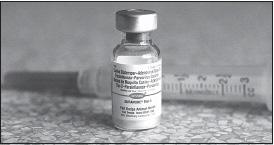We’ve come a long way, baby – on paper, at least. In the past decade, the veterinary profession’s overall attitude toward vaccination has evolved to a point that can be tentatively termed progressive.
In 2002, the American Veterinary Medical Association issued a policy statement that urged veterinarians to “customize” vaccine protocols for individual patients, since there is “inadequate data to scientifically determine a single best protocol” for initial or repeat vaccinations.

288
A year later, the prestigious American Animal Hospital Association (AAHA) released its landmark canine vaccination guidelines, which were updated in 2006. The AAHA guidelines separate vaccines into different categories – core, noncore, and not recommended at all and suggest that veterinarians revaccinate for core diseases such as parvovirus and distemper no more than every three years.
Most veterinary universities have followed suit, teaching their graduates that, depending on the disease in question, yearly vaccines are now the exception, not the rule.
But while the idea of “annual shots” should be as antiquated as wringer washing machines, it is alive and well among some veterinarians who either have not taken the time to understand the new paradigm – or have chosen to ignore it.
“We haven’t gone anywhere in some cases, and I think there are several reasons,” says veterinary immunologist W. Jean Dodds of Santa Monica, California. One of them is simply inertia.
“The veterinary profession has been convinced for so long that vaccines were essential,” and that sort of thinking is hard to change, particularly when vaccine labels can be misleading, says Dr. Dodds. “I think veterinarians assume the label [identifying a given vaccine as a one-year product] is a requirement, and interpret it more strongly than the vaccine companies intended,” Dodds says. “And the companies don’t try to dissuade them because that’s what the USDA has told them to say.”
Bureaucracy aside, many veterinarians and veterinary practice managers may be concerned that abandoning annual vaccinations will hurt their practices’ bottom line. Bob Rogers, a veterinarian and vaccination critic from Spring, Texas, refutes that fear. When he switched to a reduced vaccination schedule, “my vaccine income dropped 7 percent, but my overall income went up 20 percent. When people find out they don’t have to spend a whole lot on vaccines, they spend that money on something the dog really needs, like teeth cleaning.”
One impetus for reevaluating vaccine protocols has been concern over adverse vaccine reactions, both acute and chronic. All veterinarians recognize signs such as anaphylactic shock (a severe allergic reaction), or flu-like symptoms such as low-grade fever, malaise, diarrhea, and loss of appetite. But they may not make the connection between vaccinations and temperament changes (particularly after the rabies vaccine), seizures, autoimmune diseases such as hemolytic anemia and thrombocytopenia (reduced platelet count), or hypertrophic osteodystrophy (severe lameness in young growing dogs), which may surface weeks or months after vaccination.
And many owners are equally oblivious. “If an owner sees her dog hiding under the table after a vaccination, or the dog doesn’t want to be touched, they don’t call their vet with that information,” Dr. Dodds says, but instead might dismiss it as the dog having an “off” day.
Dr. Dodds notes that some advocates for minimal vaccination have done more harm than good by overstating the issue, implying that virtually everything is caused by what’s in that syringe.
“Many environmental challenges can cause problems, and vaccines are just one of them,” says Dodds, ticking off other possible suspects, such as topical flea and tick products, and environmental pesticides and insecticides.
Personal experience is a powerful motivator, and some vets insist on vaccinating annually for diseases such as parvo because they remember the widespread fatalities when the disease was prevalent decades ago.
Dr. Ron Schultz, chair and professor of pathobiological science at the University of Wisconsin’s School of Veterinary Medicine in Madison, notes that the flip side is true, too: Veterinarians whose own animals experience vaccine reactions are reluctant to reflexively vaccinate.
“Boy, are they ever believers,” says Dr. Schultz, who was a member of the AAHA task force that revised the 2006 guidelines. “As I often remind them, ‘When it was your animal, you didn’t care whether this occurs in one out of 10,000 animals, did you? It was your one.’”
Core vaccines
The 2006 AAHA canine vaccination guidelines single out four vaccines that are “musts” for every puppy: canine hepatitis (the adenovirus-2 vaccine), distemper, parvovirus, and rabies.
The guidelines recommend that the first three vaccines in that list be administered in a three-part puppy series, boostered at one year, then readministered no more than every three years.
Schultz notes that “no more than” could also be interpreted to mean “never again.” He points to studies that show that dogs properly immunized in puppyhood maintain lifetime immunity to canine hepatitis, distemper, and parvovirus.
“Every three years is probably a completely arbitrary number,” Dr. Rogers adds. “I’ve told my clients that after one year of age they don’t need to vaccinate anymore.” Rogers estimates that in nine years, he has used this protocol on some 30,000 dogs – “and I haven’t had one vaccine ‘break’ [failure].”
But he has seen a welcome decrease in adverse reactions. Dr. Rogers says he used to see at least one animal a week suffering from an adverse reaction to a vaccination. Now he’s down to three a year – almost always Dachshunds, a breed that he finds particularly vulnerable to vaccine reactions.
Other at-risks breeds include Akitas, Weimaraners, Standard Poodles, American Eskimo Dogs, Old English Sheepdogs, Irish Setters, Kerry Blue Terriers, and Cavalier King Charles Spaniels.
Even if a veterinarian is reluctant to stop vaccinating for these core diseases after the one-year booster, Schultz says that “every one of the major vaccine manufacturers has demonstrated that their current product, or one they’ve had for quite some time, has a minimum duration of immunity for three years,” regardless of what the label says.
“Only one company actually did it in a way that allows them to put ‘three year’ on the label according to USDA requirements, but it’s meaningless,” he says. In other words, parvo, distemper and canine hepatitis vaccines labeled “one year” have been proven to be effective for at least three.
Schultz also reminds that “other than rabies, there is no requirement to vaccinate with anything. And there’s no legal implication to any vaccine label with regard to duration of immunity, except for rabies.”
Why rabies is different
As those caveats suggest, the fourth core vaccine, rabies, offers far less wiggle room, because its administration is dictated by state laws – laws that were put into place to prevent this zoonotic disease from being transmitted to humans (see sidebar, left). An annual rabies “shot” was once the norm; in recent years, most states have changed their laws to allow a three-year vaccine, though there are a few stragglers that stick to annual rabies vaccination requirements.
The one-year and three-year vaccines on the market are actually the same product, capable of conveying the same duration of immune response. But vaccines that are labeled “one year” satisfy the legal requirement for rabies vaccination for only that long. Legally, a dog who receives a one-year vaccine must get vaccinated again a year later, even if he lives in a state with a three-year law, and even if titer tests indicate that he’s protected against rabies.
To defend your dog against needless (and in the opinion of holistic veterinarians, potentially harmful) overvaccination against rabies, it’s imperative that you know the rabies requirement in your state. If you live in a state with a three-year law, make sure your veterinarian administers a three-year vaccine.
Also be sure to check your records; in an effort to increase client compliance, some veterinarians mail out rabies revaccination reminders after only two years to avoid a lapse in the three-year coverage that a given state law mandates.
Dr. Dodds notes that the rabies vaccine causes the greatest number of adverse reactions. As a result, owners of chronically ill dogs, or those who have had previous vaccine reactions, might want to consider applying for a rabies waiver.
To obtain a rabies waiver, the dog’s primary-care veterinarian must write a letter indicating why vaccinating the dog in question would be an unsound medical decision based on his health status. Though a rabies titer is not required – and can be expensive, from $75 to $150, depending on your location – Dodds nonetheless recommends doing one.
“Let’s say down the road there is an allegation that your dog bit someone,” she says. Even if the owner has obtained a rabies waiver, it does not exempt the dog from the possibility of being euthanized so that his brain can be examined – the only definitive diagnostic test for rabies. “If you’ve got the titer as proof that the animal has immunity, then the animal won’t be automatically impounded or destroyed.”
Dodds notes that some municipalities, such as Los Angeles County, have decided not to accept rabies waivers. Others will tell callers that they do not, but on receipt of the vet’s letter and titer the responsible public health official will review the case and may issue one anyway.
Because relatively few people request them, rabies waivers are a murky area that municipalities handle on a case-by-case basis. But Dr. Dodds worries about those owners who apply for them even though they do not have a sick dog; instead, they simply believe that the rabies vaccine has a longer duration of immunity than three years, and that the law is requiring them to overvaccinate.
While Dodds might agree in theory (the proposed rabies challenge study she and others are actively pursuing hopes to prove just that), she can’t condone the practice. As their numbers grow, such noncompliant owners increase the risk of triggering legislation that might bar the practice of waivers altogether – and in the process force their ill and immunocompromised counterparts to submit to vaccinations that could make them sicker, or worse.
Noncore vaccines
While the AAHA guidelines do not consider core vaccinations negotiable, noncore vaccine are, with their use determined by a dog’s risk factors.
One looming consideration is geography: In many parts of the country, leptospirosis and Lyme disease are simply not prevalent. But in areas where these “noncore” diseases are endemic, owners are faced with tough decisions about less-than-perfect vaccines.
For example, leptospirosis, which is most often spread through contact with the urine of an infected animal, has 200 different serovars, or strains. Only four strains (icterohaemorrhagiae, canicola, grippo-typhosa, and pomona) are covered by vaccines, which themselves are notoriously shortlived.
“The antibodies only last a short time n the body; they can be measured only by titers for one to two months, and [the titer levels] are low in the first place,” Dodds says. The vaccine manufacturers, in turn, maintain that a vaccinated dog is protected by its cell-mediated immunity, which cannot be measured by titers.
For dogs at high risk for leptospirosis, which has diffuse symptoms and can cause liver and kidney failure if caught too late, Schultz recommends using the four-strain vaccine instead of the two-strain product (which addresses the icterohaemorrhagiae and canicola serovars), first at 14 to 15 weeks (but not before 12 weeks), repeated two to four weeks later. Subsequent doses are administered at 6 months and one year, and thereafter every six to nine months.
Even so, Schultz notes, “I find there’s still a fairly high percentage of dogs that do not respond to the vaccine.” Plus, of all the bacterin vaccines, leptospirosis causes the most adverse reactions. (For this reason, many holistic veterinarianss administer it separately and weeks apart from other vaccines, a practice they recommend with the rabies vaccine as well.)
The pros and cons of the Lyme vaccine are not any easier to navigate. In some areas where the disease is endemic, Schultz says practitioners are no longer vaccinating because they believe they are seeing as many vaccinated dogs with clinical disease as unvaccinated ones.
Instead of administering the vaccine, some owners are choosing to treat their dogs prophylactically with antibiotics if they suspect a tick bite. Regardless, good tick preventive is key, whether it’s in the form of an insect-repelling herbal spray or a systemic flea and tick product, though the more holistically oriented tend to avoid the latter because it exposes a dog’s body to still more chemicals.
If owners choose to vaccinate for Lyme, both Dodds and Schultz recommend using the recombinant vaccine instead of the older bacterin one, which can cause symptoms similar to the disease itself, such as lameness and joint pain.
The recombinant vaccine does not contain the additional antigens that are in the bacterin vaccine, but instead contains only outer surface protein A, the antigen that inactivates the tick when it takes its blood meal, which is the point at which the disease is transmitted.
As a rule of thumb, Schultz does not recommend the vaccine for dogs living in an area where the rate of infection is less than 10 percent. “Greater than 50 or 60 percent, then give it some serious thought.”
In the case of both Lyme and leptospirosis, which can be treated with early invention and antibiotic therapy, Dodds says that involved, observant owners who note any early and sometimes vague symptoms can literally save their dogs’ lives.
The condition commonly known as “kennel cough” is addressed by other noncore vaccines, including canine para-influenza virus (notated as CPiV or simply called parainfluenza) and Bordetella.
Unfortunately, few dog owners understand that kennel cough is a complex syndrome rather than an individual disease attributable to one specific pathogen. In addition to a buffet line of various viruses and bacteria (including the two mentioned above), factors that make a dog susceptible to kennel cough include stress, humidity, gasses such as ammonia from unhygienic environments, and nitrous oxide from exhaust fumes. That’s why a dog who received a parainfluenza or Bordetella vaccine may well still contract kennel cough.
Dogs who get out a lot, such as those who visit dog parks or dog shows, will be regularly exposed to many factors that can cause kennel cough. These exposures, in essence, will “vaccinate” the dog naturally, as his immune system learns to recognize and mount a defense against the ubiquitous pathogens.
In contrast, dogs who lead highly sheltered, nonsocial lives may become quite ill in the rare event that they are exposed to the kennel-cough pathogens. “If any dog needed a kennel-cough vaccine, it would be one that’s never around another animal,” says Dr. Schultz. If such a dog had to be kenneled unexpectedly, a dose of the intranasal Bordetella vaccine might not prevent the disease entirely, but it could mitigate its severity, which is better than nothing.
According to Dr. Schultz, when properly immunized dogs are exposed to infectious material of those “core” diseases, he is confident they will not contract the disease. He can’t say the same for leptospirosis, Lyme disease, or kennel cough; the existing vaccines are just not that effective or long-lived. Dr. Schultz concludes about noncore vaccines, “No matter what you do, there’s going to be a risk. And that’s what we really have to measure.”
Not recommended vaccines
AAHA has various reasons for putting a vaccine in its “not recommended” category. One is simply a “lack of experience and paucity of field validation of efficacy,” which is the case with the vaccines for rattlesnake bites and periodontal disease.
The giardia vaccine is on the “no” list because it does not prevent a dog from getting infected – only from shedding the disease. Similarly, the adenovirus-1 vaccine earns the red light because it can cause “blue eye,” a clouding of the cornea, and because the core adenovirus-2 vaccine already protects against it.
In the case of coronavirus, the AAHA task force made the point that the disease is simply not prevalent enough to warrant vaccinating for it.
“People don’t have a clue that coronavirus doesn’t make dogs sick,” says Dr. Rogers, noting that puppies less than six weeks old develop a loose orangey stool that resolves on its own within 24 hours. “Puppies over six weeks of age are immune to it whether vaccinated or not.”
Indeed, he says, vaccine companies have had difficulty testing the vaccine on sick dogs because none can manage to contract it. But the vaccine can be licensed by the USDA because it does prompt a dog’s body to produce coronavirus antibodies.
Managing your veterinarian
Even if your veterinarian continues to recommend annual vaccines, as a client and consumer you have the right to request a different protocol. Depending on your approach, the veterinarian might be more willing to modify his or her suggested vaccine schedule. But some can prove to be stubbornly entrenched in their position on vaccination.
Schultz’s own secretary was fortunate when she was unable to get past her veterinarian’s insistence on revaccinating her dogs. In frustration, she handed the phone to Dr. Schultz, who has the same sort of name recognition in veterinary circles as Tom Cruise does in most American households. After a brief exchange, Schultz returned the receiver to his secretary, who now found the vet more than willing to accede to her request for a minimal vaccine schedule.
For those who cannot put one of the world’s foremost veterinary immunologists on the horn with their vet, Schultz recommends the next best thing: printing out the AAHA canine vaccination guidelines, highlighting the pertinent information, and bringing them along to the appointment.
“It really works; it helps,” he says. “AAHA is an esteemed organization that sets the highest standards for small-animal practice. Here’s what its expert panel recommends. How do you argue with that?”
The fact that you might have to argue – or at least debate – with your veterinarian to arrive at an appropriate vaccine schedule might be regrettable, but it’s hardly unexpected, given the very human resistance to change. “It’s an evolutionary process, not a revolutionary one,” Schultz concludes. “Nothing is revolutionary in medicine.”
Donations to the Rabies Challenge Fund can be sent care of Hemopet, 11330 Markon Drive, Garden Grove, CA 92841; for info, see dogsadversereactions.com/rabieschallenge.html.
Denise Flaim has two raw-fed Rhodesian Ridgebacks. The New Yorker is the author of The Holistic Dog Book: Canine Care for the 21st Century (Howell, $17). See “Resources” for purchasing information.





